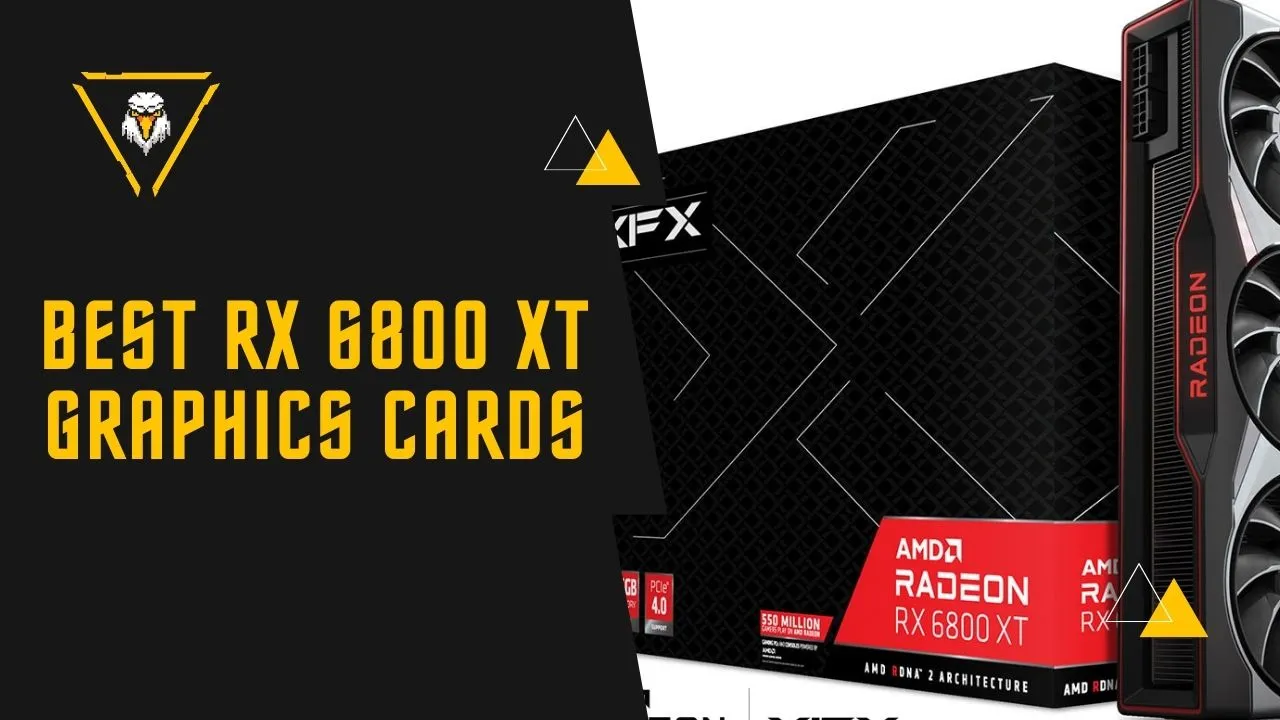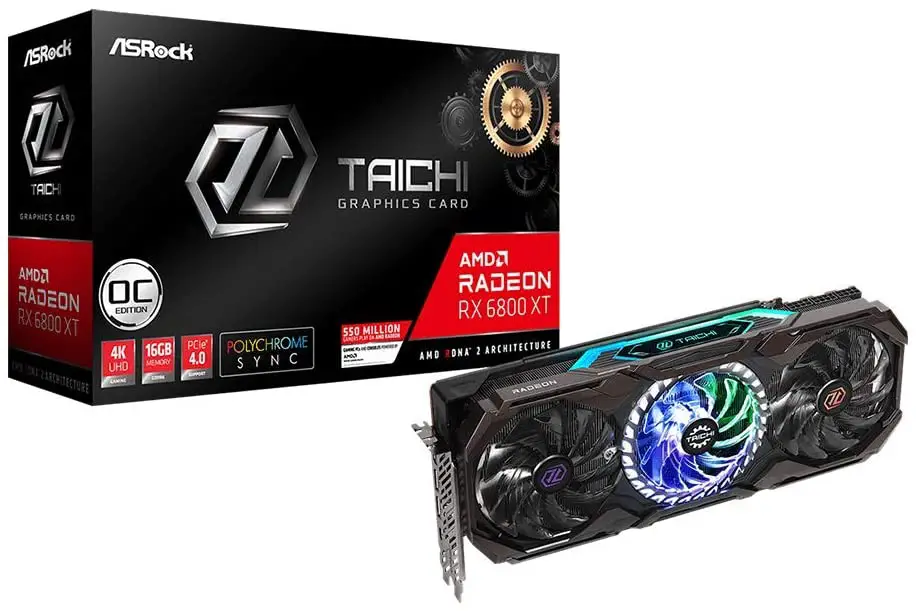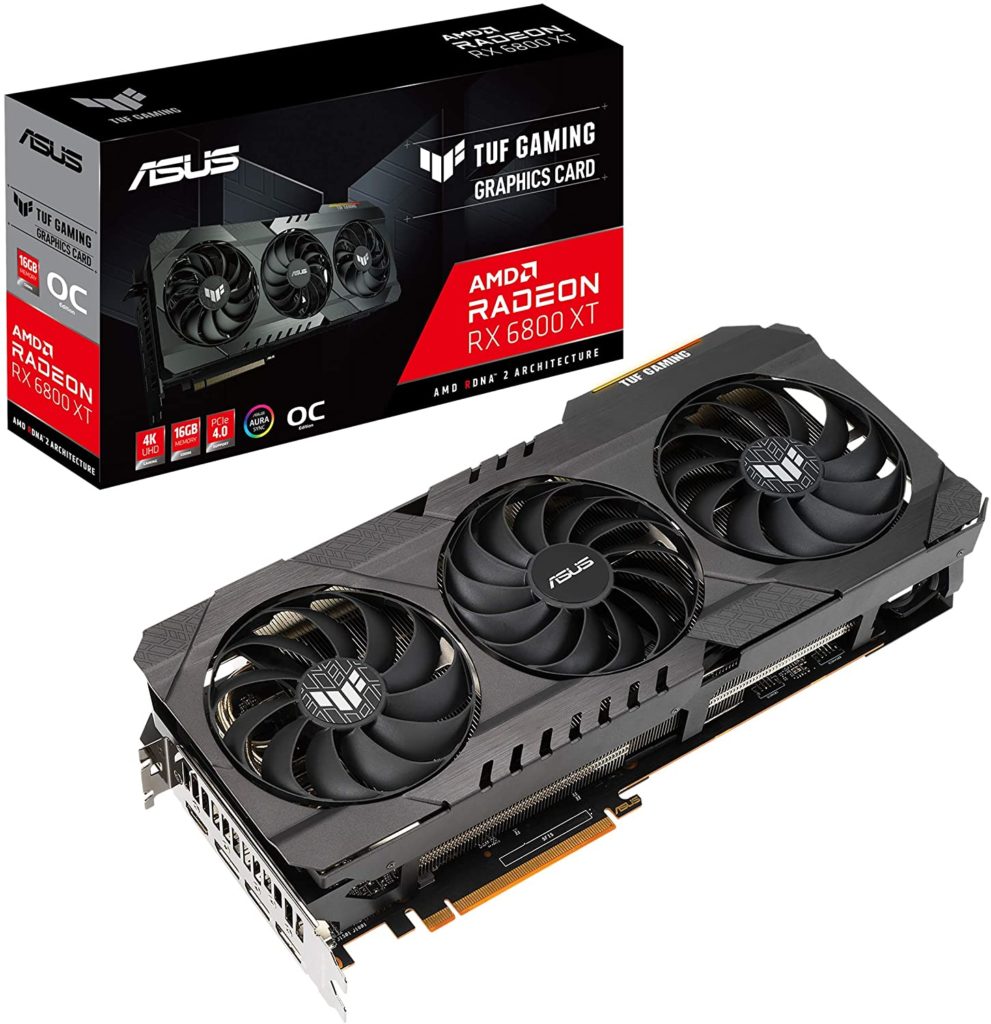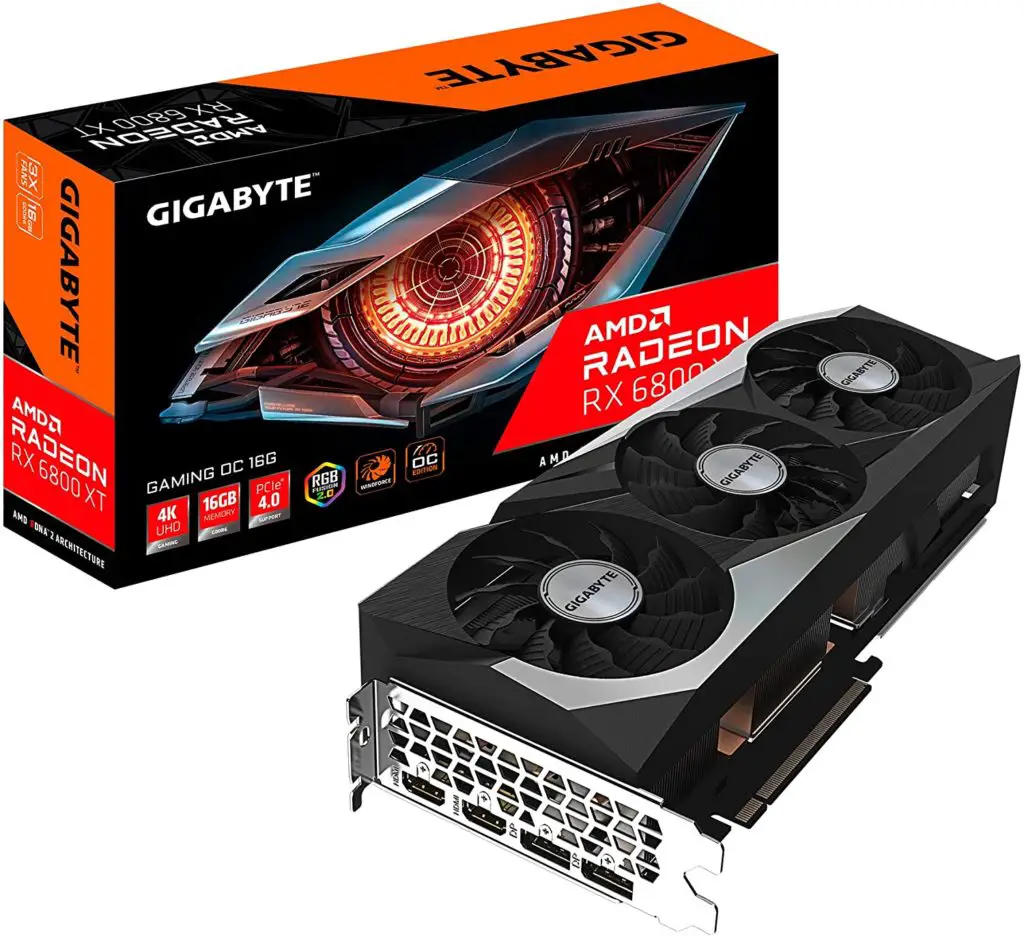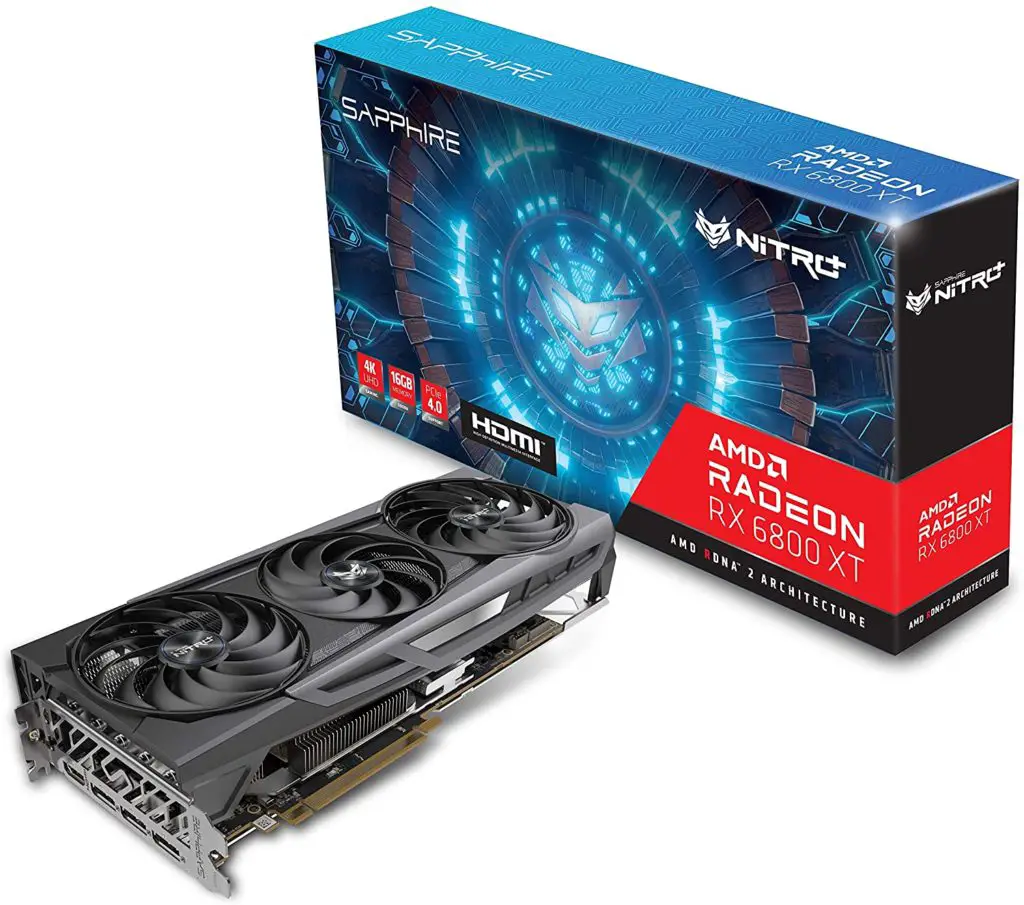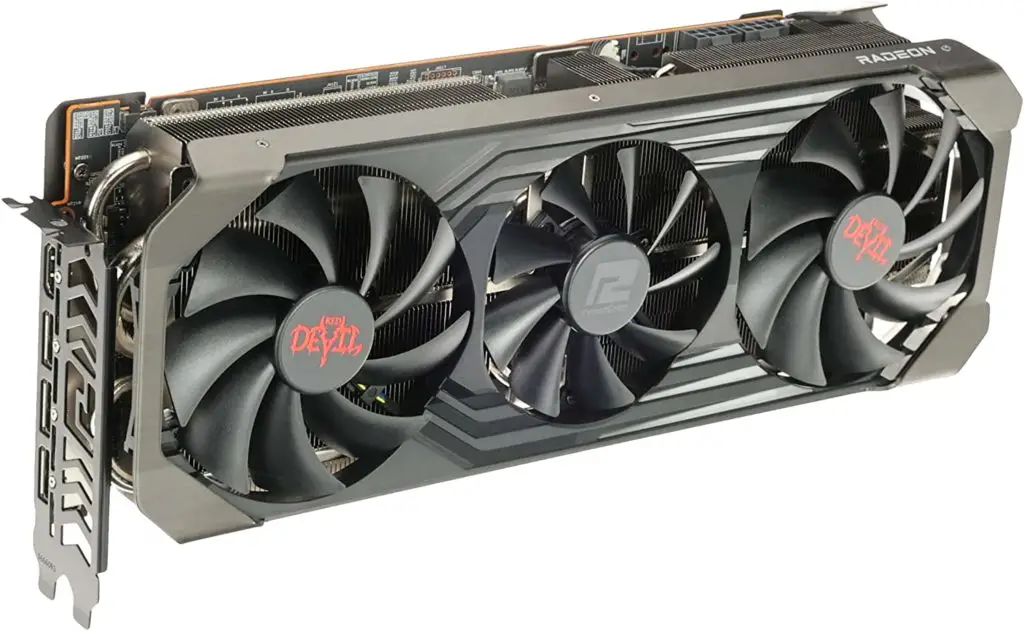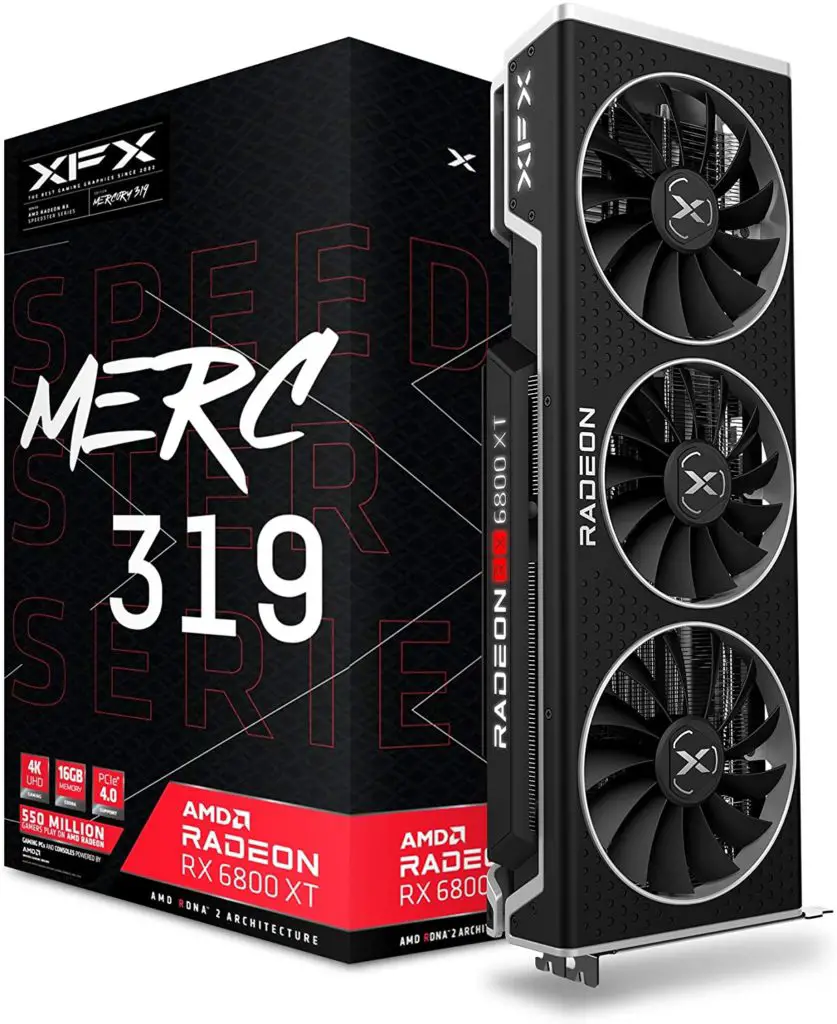The Asus TU Radeon RX 6800 XT is our recommended and best RX 6800 XT Graphics Card for gaming and workstation. AMD’s return to the top end of the market gets better with some cracking partner cards. With the launch of AMD Radeon RX 6800 XT it puts AMD back in the race at the high end of the market, and that the 6800 XT nips at the heels of the mighty RTX 3080 Ti. Can the tried and true premium tier designs and coolers from AMD’s partners beat out the surprisingly capable reference card?
The new AMD Radeon RX 6000 Series graphics cards are driven by the groundbreaking RDNA 2 architecture, engineered to deliver excellent 4K resolution gaming for gamers. The power of this technology is showcased in any game or frame that you play on it.
Our recommended list of the Best RX 6800 XT Graphics Cards
- Asrock Radeon RX 6800 XT Taichi XOC
- Asus TUF Radeon RX 6800 XT
- Gigabyte Radeon RX 6800 XT Gaming OC
- Sapphire RX 6800 XT Nitro+
- PowerColor Red Devil AMD Radeon RX 6800 XT Gaming Graphics Card
- XFX Speedster MERC 319 Radeon RX 6800 XT CORE Gaming Graphics Card
1. Asrock Radeon RX 6800 XT Taichi XOC
There are subtle cards, silent cards and affordable cards and then there’s the Asrock Taichi X. This is a card that demands to be shown off in a case with a PCie riser. It’s the joint highest clocked of the tested cards and the highest performing one too.
It’s got everything including a strong PCB design with dual BIOS, lashes of RGB lighting (that can be turned off via a switch) and a powerful cooler with Odb mode. At $1,499 its price is surprisingly reasonable compared to other flagship tier cards.
The Taichi X consistently topped the testing leaderboard and in some cases got close to the 6600 XT Graphics Card and 6900 XT GPU. The Taichi was among the hotter running cards. It also gets audible under load but it’s still nothing like the noisy blower cards of old. The card requires three 8-pin PCIe power connectors, which means th67ere’s some serious power on tap if you want to push it hard. Asrock rates the TDP at 300W though we think it’s higher than this after measuring a peak 289W GPU power draw, the highest of the test.
Contrary to its name that suggests peace and harmony, the Taichi X is big, bright and in your face. At $1,499 it’s pricey a couple of months ago, but it’s truly expensive now. Whether the cost is worth it over the likes of the Sapphire may depend on whether you want to show it off or not. As the fastest and most unmistakably premium card of the test, it’s pretty hard to top the Asrock Taichi X.
2. Asus TUF Radeon RX 6800 XT
The Asus TUF Gaming 6800 XT is huge! Asus has many different cards in its portfolio with the Strix and LC positioned as the performance kings whereas the TUF is clearly tuned for cool, quiet and reliable running. This is a card that you’ll put into your case and happily play away at 4K, out of sight and out of mind.
The TUF is clearly positioned as a set and forget card, with a focus on reliability as its design theme. An aluminum shroud, custom PCB and even the weight of it point towards an outstanding cooling capacity. RGB is kept to a minimum.
The Asus TUF was easily the quietest and coolest card of the test. That huge triple slot cooler gave us the best temperatures too. It’s got a small section that allows air to pass through to the rear of the card, a little like the Nvidia Founders Edition cards do. Is this a new way to gain maximum cooling effectiveness? With all the focus on cool running, the TUF didn’t perform as well as the other tested cards but it’s still ahead of the reference 6800 XT.
The Asus TUF 6800 XT is one for buyers who want a card out of sight and out of mind that performs reliably and silently without the excessive bling common to many top tier cards. It comes at a cost though. That price is sure to drop as production stabilises. When that time comes, fans of silent gaming will find the TUF a very compelling option.The Asus TUF runs exceptionally cool and quiet, but its price is too high right now.
3. Gigabyte Radeon RX 6800 XT Gaming OC
The Gigabyte Gaming OC is one of the company’s more value oriented offerings, sitting below the premium Aorus products. It’s the most compact of the cards. Though it’s still a triple slot card, its height makes it easier to fit into smaller cases.
The Gaming OC uses the company’s Windforce 3X cooler. It’s got dual BIOS’ and the RGB Gigabyte logo on the side is the only RGB present. It’s a card that eschews bling. That alone will appeal to many users. Notably it comes with a pair of HDMI ports to go with two DisplayPorts. It’s the only card in the test with this configuration.
Despite its relatively low rated boost clock, the Gigabyte performed better than expected. It appears that this card is a strong sample in terms of the silicon lottery. A measured GPU chip power draw of 264 watts meant the card was able to consistently boost higher. In fact the card was able to maintain an average boost clock of 2,350MHz (only behind the Asrock). The card isn’t loud by any means, though it does become notably audible under a sustained load.
The Gigabyte Gaming OC is a good all-rounder, offering surprisingly strong performance to go along with a more compact and subtle design. It’s not the quietest card in the test and its prerelease pricing is on the high side which hurts it. We can’t put too much weight on pricing volatile markets though. The Gigabyte Gaming OC will surely become a more compelling option as volume picks up and pricing settles to more representative levels.
The Gigabyte Gaming does the job of a value offering, though it needs to drop in price.
4. Sapphire RX 6800 XT Nitro+
The Sapphire RX 6800 XT Nitro+ sits above the Pulse in its lineup. It makes use of a large triple slot and triple fan cooler. It too makes use of a large cut out on the rear to allow air to pass through the backplate.
The Nitro+ PCB is a high quality one, making use of a 13-phase VRM powered by dual 8-pin power connectors. Notably it’s the only card in the test to omit a Type-C USB port in favor of a triple Display Ports and a single HDMI. Those triple ports alone may make the Nitro+ a favorite of triple screen users. There’s also a dual BIOS. Switching to the quiet BIOS lowers the power limit by 25W which means lower clocks. There’s a 3rd switch setting which enables control via Sapphire’s Trixx software app. There’s an RGB light bar and logo across the top of the card.
Despite its highly advertised boost clock the Sapphire couldn’t quite match the Asrock in performance. The differences between all the tested cards aren’t significant though. The Sapphire proved to be a capable performer whilst keeping noise levels and temperatures in check. It strikes a very good balance.
The Sapphire impresses with its all-round capabilities combined with great value. It was once one of the cheaper options on the market, but the current volatility has hit it hard. Again though, 6000 series pricing is influenced by very low stock levels so the price now probably won’t be the price in December and so on. We’re happy to declare the Sapphire Nitro+ the pick of the bunch.
The Sapphire Nitro is a great all-rounder that’s further elevated by its surprisingly good value.
5. PowerColor Red Devil AMD Radeon RX 6800 XT Gaming Graphics Card
Enhance your gaming experience with the new Red Devil RX 6800 XT Limited Edition. It features a unique noiseless cooling system that keeps it running at low temperatures while providing high performance to you throughout your gameplay. The RGB lighting on its sides, shroud and back also gives this graphics card an aesthetically appealing look for those who care about appearances as much as they do their games! Lastly, this limited edition comes with a special red keycap which will make sure everyone knows how exclusive of a gamer you are when showing off in front of them during LAN parties.
The PowerColor Red Devil RX 6800 XT features a triple fan design with 7 heatpipes and 320mm cooler, this GPU is equipped to manage the high power demand of games by providing ultra-efficient cooling. The state-of-the art PCB uses 14+2 VRM for stable voltage regulation while two 8 pin PCI E connectors provide enough capacity to support demanding applications like gaming or Crypto currency mining which can use up more than 200 Watts from your graphics card.
Users will also have peace of mind knowing that they are using DrMOS chips paired with polymer capacitors in their PC’s system as well as an attractive red themed color scheme on both the board itself and all shrouds included in its package offering users added value when purchasing this product!
With the push of a button, you can choose OC Mode which allows for top-of-the line games to be handled easily. Silent mode provides an excellent quiet gaming experience that is easy on your ears and eyes as well!
AMD Radeon Anti-Lag and AMD Radeon Boost help propel your gaming experience with low latency VRR technology. Up to 1250 displays are compatible for smooth gameplay while using the latest HDMI 2.1, VRR technology, VR headsets or other technologies such as USB C enabled devices.
6. XFX Speedster MERC 319 Radeon RX 6800 XT CORE Gaming Graphics Card
With the power of AMD Radeon™ RX 6800 Series graphics cards, you’ll be able to experience ultra-high frame rates. These powerful new compute units are paired with up to 16GB GDDR6 memory and will provide a fantastic gaming performance when paired with an AMD Ryzen™ 5000 series desktop processor.
The XFX Force Speedster MERC 319 Radeon RX 6800 XT CORE Gaming Graphics Card is optimized for 4K gaming and 1440p high frame rate performance. It features 16GB of ultra-fast GDDR6 VRAM to deliver better graphics rendering at higher resolutions than the previous RDNA generation, providing an immersive experience with your PC games.
The front panel of the card features a variety of outputs, such as DisplayPort 1.4 and HDMI 2.1. The Radeon RX 6800 XT supports APIs, including DirectX 12 Ultimate and OpenGL 4+. These APIs can take advantage of the GPU’s 4608 Stream Processors to accelerate parallel computing tasks that would otherwise be handled by your CPU or other components in order to save processing power for games instead! To cool all these powerful specs down XFX Force implemented a triple fan cooler which is great news because many high end GPUs are known for being hot so it’ll keep you playing comfortably longer.
The front panel on this graphics card has various ports like DisplayPort 1.4 and HDMI 2.1 support with 8K @ 60fps resolution.
What Makes Them Tick
Before we get to leave the roundup, let’s revisit some of what’s under the hood of the Radeon RX 6800 XT, AMD’s first RDNA2 GPU. The 6800, 6800 XT, and 6900 XT are all based on the 7nm Navi 21 GPU. They share the same memory subsystem, consisting of 16GB of 16Gbps memory over a 256-bit bus. The major difference between them is the clock speeds and number of computing units, with all 80 enabled for the 6900 XT, 72 for the 6800 XT, and 60 for the 6800. Each CU contains 64 shader units and a single Ray Accelerator (or RT core if you adopted the Nvidia parlance).
The 6800 XT is the sweet spot card of the three. It doesn’t cost too much more than the 6800 and at this end of the market a 10 or 15 percent price premium over the 6800 probably won’t deter too many buyers. Once the market matures, we may see premium 6800s around the same price as an entry level 6800 XT. It will present an interesting conundrum for many buyers. The 6800 XT is quite a bit cheaper than the 6900 XT. Much like the super expensive RTX 3090, diminishing returns set in at the very top end of the market.
Advanced Tech Features
The 6000 series brings ray tracing to AMD’s lineup for the first time. AMD is yet to introduce its DLSS competitor it calls Super Resolution, but it is working on it. Until now we’ve been under weighting ray tracing capabilities due to limited game support and the performance hit that comes when you enable it. But with the release of a major title like Cyberpunk 2077 that really shows off the tech at its best, that time is over.
It’s now a must-have tech and cannot be viewed as a bonus any longer. Ray tracing and resolution up scaling in one form or another are going to become standard graphics features in the coming years. We’re yet to see how AMD’s GPUs and the next-gen consoles handle the advanced Cyberpunk 2077 features, but there’s no underselling it any longer. AMD can’t fall behind. Note that AMD doesn’t have an equivalent to Nvidia’s Tensor cores so it will be interesting to see how AMD performs things like deep learning and Al operations.
AMD offers some interesting features including Smart Access Memory, which allows the CPU to access more or all of the GPU’s memory. Some games see significant gains of 10% or more. As it’s a PCIe feature, it’s being enabled on Intel platforms too. Additionally, Nvidia has also announced it will add support in a future driver update. Make sure you enable the settings in your BIOS. It goes by different names and involves adjusting one or two settings. Who doesn’t like free performance?
The other particularly interesting feature is something AMD calls Infinity Cache, which is essentially a level 3 cache. At 128MB it’s very large. It takes up a big chunk of the GPU area. AMD claims it reduces the need for very high memory bandwidth. This means a 256bit bus and GDDR6 is sufficient. In theory this means the cards are not overly complex, hopefully resulting in lower manufacturing costs. If the availability woes go away, some nice bargains could be possible. A price war would be great for the consumer!
Availability or a lack thereof is the elephant in the room. It’s terrible to put it mildly. Some reports state component shortages are to blame, or is it miners buying up container loads? The coronavirus? Perhaps it’s the lack of foundry capacity? At the time of writing it was next to impossible to buy a console off the shelf anywhere in the world so there are some serious supply issues. This means pricing is highly volatile. A recommended retail price isn’t reflecting reality.
Some cards are facing months of back-orders. It appears that supply and price gouging issues will persist well into this year. There will be many disappointed gamers over Christmas.
Performance
Custom cards manufacturers have their work cut out for them. In our testing the reference 6800 XT cooler proved to be a massive step forward over the noisy blower style coolers from previous generations. It’s also much better than the outwardly similar cooler of the short lived Radeon VII. It’s not all about the cooler though. The custom cards tend to have more robust PCBs, support for higher power limits and overclocking and as you’d expect, loads of RGB! The other factor to consider is that the reference card probably won’t be around for long. In six months any comparison to the reference card may well be moot.
Speaking of overclocks, the Asrock and Sapphire cards offer the highest GPU clocks we’ve ever seen at an incredible 2,360MHz, though actually they can sustain themselves even higher than that! AMD and its foundry partner TSMC really deserve credit for extracting this kind of power efficiency from a GPU without having to resort to a brute force approach. The fact that AMD is able to keep the TDP of the 6000 series to 300W is admirable. 300W isn’t the limit though, as some of the partner cards will move beyond this. At least the monster coolers are capable of handling the heat, and doing it quietly, if not silently.
It’s overly simplistic to assume that partner cards are all the same. You need to ask yourself: What is it that you look for in a GPU? Ask ten different people and you’ll probably get ten different answers. Do you want the fastest card you can get? The quietest? The best looking one? Do you want bang for your buck? In the current climate perhaps you’ll take whatever you can find in stock! Whatever your priority, one of these cards will suit you. These 6800 XTs are quite distinct from one another and one of these cards will surely impress. Let the games begin!
